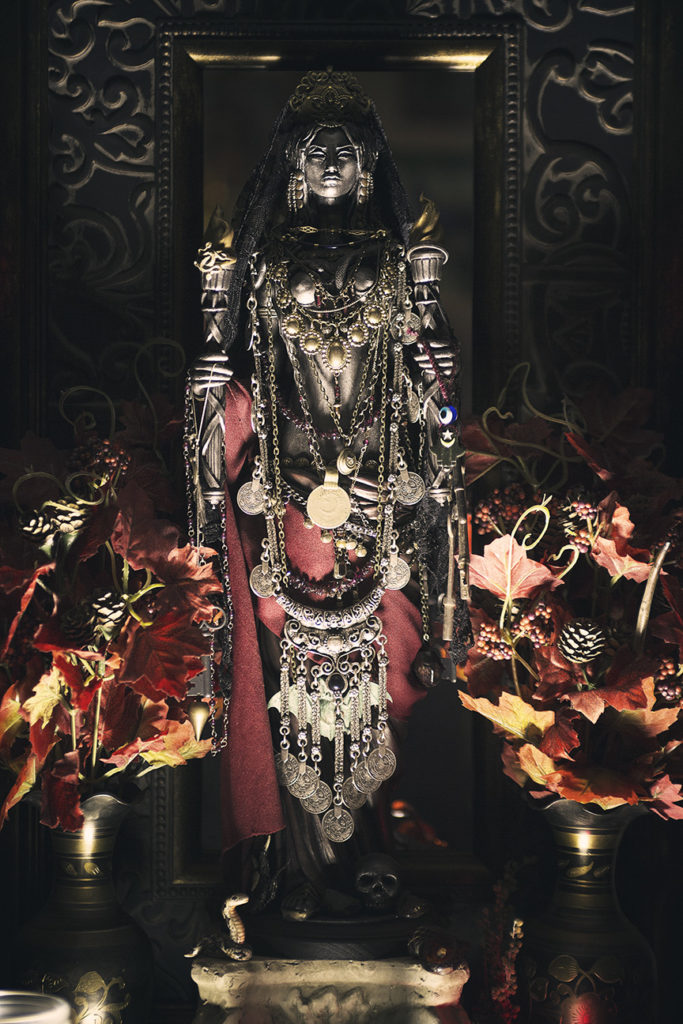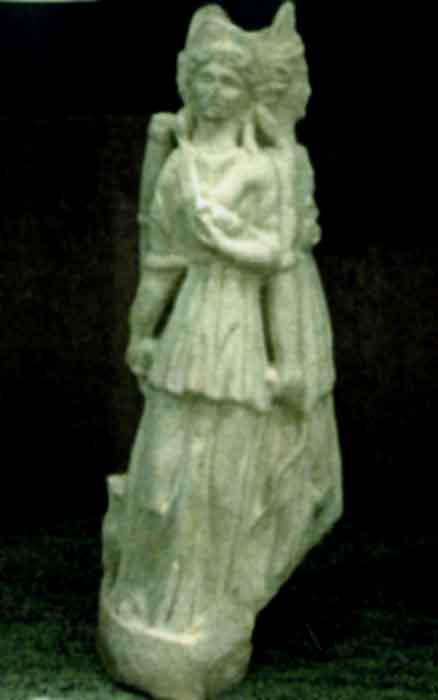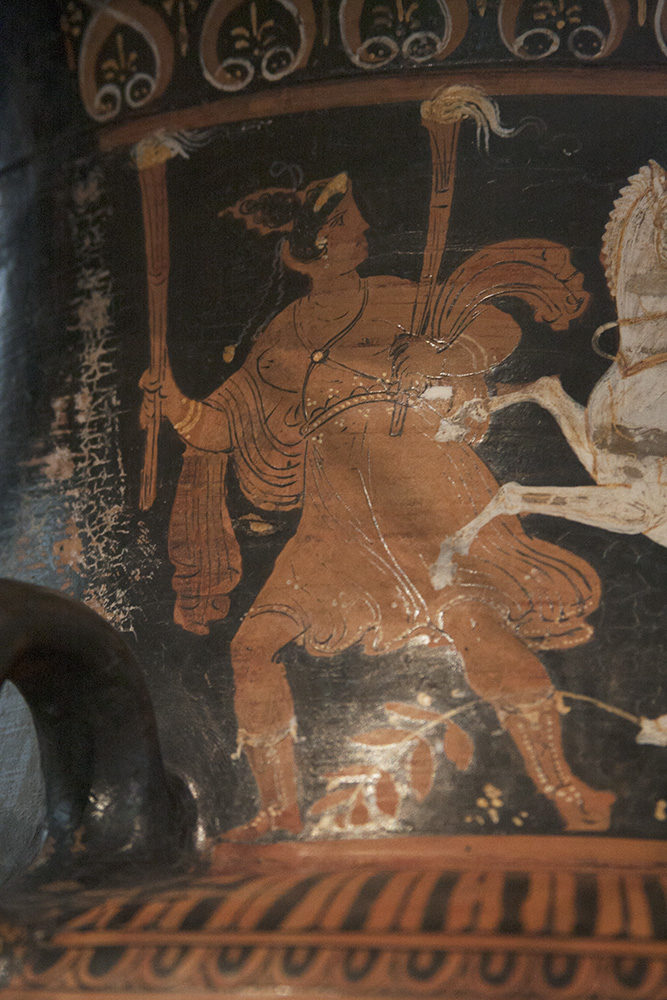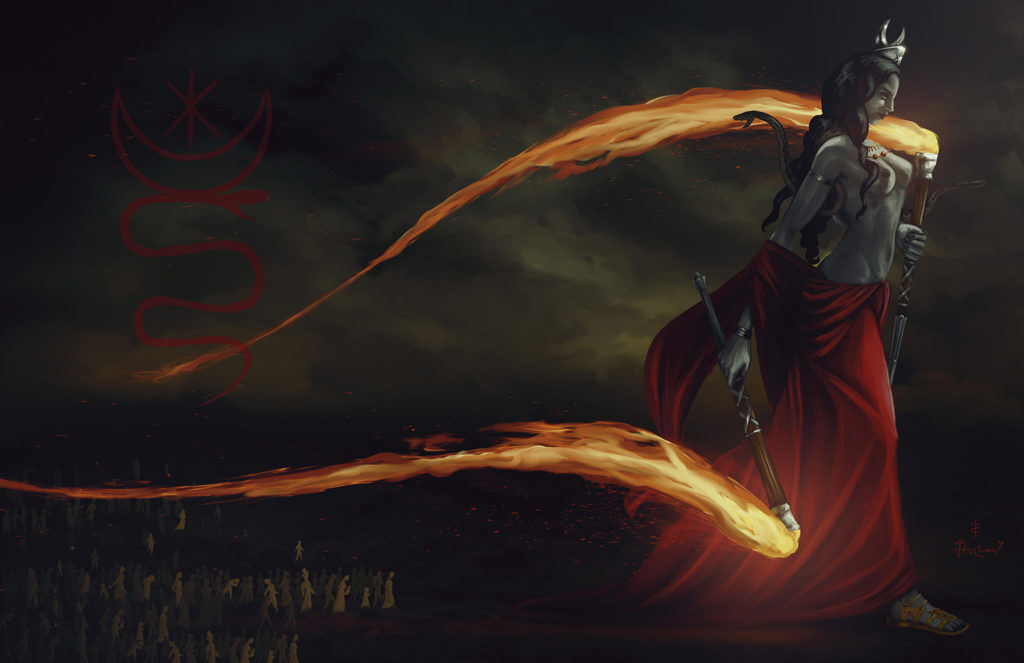
It is no surprise that my favorite art subjects are my patron Gods, Pan and Hekate. However, overwhelmingly it is Hekate Who has been my most popular, especially among polytheistic witches. This is because my representation specifically focuses on Her as Queen of Witches. It is for this reason that my iconography of Hekate has been so controversial.
My cult iconography pulls from many sources, either personal or historical. So what do they all mean? To start, we need to understand the cult itself. This is not the conventional cult we see widespread across the Hellenic world that primarily focuses on Hekate’s role as guardian of boundaries. The imagery, most often from Athens, contains many familiar attributes one would expect to find representing the various guardianship functions.
The History of Her Image
Most notably are Her three forms. These three forms , either as three figures back to back (Trimorphis) or as three faces (Triceps), watch the triple crossroads (Enodia, or Trioditis). This element is universal among most representations of Hekate both ancient and modern, of course with exception. This is because the crossroads is an element that has depth of meaning. First, it is a physical boundary where scoundrels, both natural and supernatural, converge particularly at night. It is Hekate Who guards this space, and when She looks favorably on a person they are under Her protection there. The crossroads is also deeply spiritual in the sense that it is a place where energy crosses and overlaps and is in constant motion. This makes crossroads attached to the ether of the Cosmos itself, a place where supernatural energy is evoked. Lastly, it is a place of the Dead. In ancient times the bodies of criminals would be buried at triple crossroads to prevent them from rising from the grave and finding their way back to town, wreaking havoc on their executioners. In modern times, sadly, many fatal accidents happen at crossroads and that death energy permeates the area. With Hekate’s guidance and guardianship a witch is free to summon these forces to do their bidding.

The next familiar attribute on most depictions of Hekate are Her twin torches. These have many interpretations but distinctly there are two. This separates Hekate’s iconography from that of other torch carrying Goddesses such as Demeter and Persephone, and even our Statue of Liberty depicting the Goddess Libertas here in the United States. The function of these torches illuminate (Phosphoros, or Lucifera). They burn with the fiery ether of the Cosmos, what I refer to as the Witch Flame. They also serve as watchtowers that guide the devotee through the darkness. Some have interpreted the twin nature of Her torches as being one to guide, and one to pass to the one being guided, much like when Hekate escorts Persephone through the Underworld. Her torches also have a defensive purpose. She can use them to immolate Her enemies as She did when battling the giant Klytios. Another function Her torches serve are as the lights that attract the wandering dead whom She collects on Her nocturnal haunts.
Past these attributes Her iconography starts to vary based on function. It is important to note that most of the representations we have of Hekate from antiquity come from household shrines called Hekataion. The elements held by the Goddess typically represented a protector of the home and entrance among other divine functions. For example, a lot of statues carry a patera and pitcher. This can be seen to represent Her self sustaining ability, that She does not depend on the libations of mortals because She can do it Herself. We see this as a recurring motif in the ancient Greco-Roman world, Gods libating to Themselves at Their altars. Next She is often holding a key (Kleidouchos) which represents Her ability to open ways, unlocking all doors. In the case of the Hekataion, She is saying it is She Who carries the key to the house and She Herself can prevent or allow entry. Often She is depicted holding a serpent, Her sacred animal. The serpent represents the Underworld and the spirits of the home whether familial such as ancestors, or the genius loci. Another animal seen on these statues is the dog, a known guardian keeping watch over the threshold.
Other attributes include an egg for purification, knife for sacrifice, a scourge or whip for punishment, often surrounded by the dancing Graces to bring happiness and pleasure to the home. To satisfy the conservative Athenian sensibilities She wears Her iconic chiton dress. Despite Her khthonic and Underworldly nature, this image was welcomed into the Athenian home, and the homes of the other Greek city states primarily because they didn’t overtly focus on Her more sinister aspects. Hekate is indeed a Goddess of many faces, and one that has been deprived of representation is Her face as Queen of Witches. When we reflect on the poetic descriptions when She is evoked in witchcraft an entirely different image emerges. She comes as a colossal, terrifying Goddess (Brimo) with locks of writhing serpents. As She ascends from the Underworld the dogs howl, serpents slither all around, and the nymphs wail and flee. In the Greek Magical Papyri She comes as a gorgon, or with the feet of wolves. Here we find Hekate Ereshkigal, Hekate as Mistress of Corpses, sender of demons and the ghosts of the dead. This is the cult my iconography emphasizes.
So why did the ancients neglect to depict Hekate in Her role as Queen of Witches associated with the Underworld that we find in rites of witchcraft and poetry on the subject? Simply put they were afraid. Physical representations of the Gods drew Their attention. The ancients avoided depicting Underworld Gods in cult imagery outside of storytelling to avoid evoking Their presence. It is the reason we do not see cult statues of Hades or even Ereshkigal (with the possible exception being the Burney Relief which is not agreed upon).
The Queen of Witches
Many modern witches have no choice but to use the iconography of the Athenian Hekataion for their work because it is largely all that is available. When I first started sculpting I also represented Her as such. That all changed when Hekate came to me in a dream and everything I used to think about how I represented Her changed. In the dream I remember being surrounded by darkness. I could only see or sense the movement of snakes all over the ground and She appeared out of the darkness, a gigantic Goddess with pale skin, the color of moonlight, Her eyes seemed to disappear as if they contained the blackness around the stars. Her hair twisted with snakes and She bore Her breasts which were garlanded by jewels. Around Her waist were chains that rang like bells as She walked. I could hear dogs barking and wolves howling in the distance and it felt like the dead were closing in around us, attracted to the light of Her torches. After the dream I instantly sculpted a new statue for myself and immediately began to depict the attributes She showed me in my iconography.
The first change, and the most controversial, are Her bare breasts. Many have criticized this attribute primarily out of a lack of understanding where it comes from and what it represents. Despite the obvious flair for nudity in Greek devotional art, something that was controversial itself when it first began, we see it primarily used to represent male Gods, whereas most Goddesses are depicted fully clothed with few exceptions such as Aphrodite, a Goddess Who embodies sexuality. When we do see the nude female regarding the divine femanine it is either used to represent pleasure and sexuality, or when one breast is exposed, nurturing. But there are also more sinister associations with the bare breasts. When depicting the feminine as wild and untamed the symbolism of the bare breasts was used, for example in the case of the sphinx or sirens. This directly correlates to the idea of female morality in the Attic citystate. It is what separates the “heroic” nude male, and the “sensual or wild” nude female. The bare breasts when not used sensually was a woman or Goddess absolved of conservative values. In ritual it is used during mourning for the dead as we see in the rites of Adonis where women bare their breasts and wail. But it was also a huge element in witchcraft. Seneca describes Medea performing her rites of witchcraft to Hekate with bare breasts and a crown of serpents reflecting the Goddess Herself. In the ancient mind, the image of a woman performing witchcraft with her breasts exposed was terrifying. It was the ultimate symbol of defiance.
But it also represents a strong association with the Gods of Darkness and the Underworld. Many Goddesses we find used as epithets for Hekate in various works of witchcraft are often depicted with exposed breasts such as Persephone, the Erinyes, Nyx, and Ereshkigal. In the Mesopotamian story of the Descent of Inanna, when the Goddess reaches Her sister in Irkalla, having passed through the seven gates stripped of all belongings She finds Her sister Ereshkigal, Goddess of the Underworld with Her breasts bare and hair down as She mourns the loss of Her husband who died because of Inanna. We also see this vaguely hinted at in vase paintings representing divinities associated with Night and the Underworld. Hekate Herself is oftentimes shown with an extremely sheer chiton with visible breast detail. For these reasons the bare breasts are one of the most identifiable features in the Cult of the Witch Queen despite the opinion of orthodox polytheists.

The next feature I include are the locks of serpents. Typically I add a snake on each side of Her primary face. For me this is a huge part of this specific cult because it is the attribute most often referenced in historical witchcraft. When scouring the market for iconography specifically representing this aspect of Hekate it is shocking to say the least that this one element is always missing. Not only do the snakes symbolize the Underworld, but they are also apotropaic, driving away evil and enemies, they reflect Her nature as Gorgon Eyed Queen Who only the brave gaze upon, those brave enough to break from convention and walk the nocturnal roads of witchcraft. The snake in the context of this cult also represents the Underworld, the force of the dead and of Darkness that is often called upon in witchcraft.
Her torches also serve a more occult role within the Cult of the Witch Queen. They hold the fiery ether that ensouls all witchcraft, that divine force that permeates everything within the Cosmos, from the stars and planets, to the minerals and plants we use. With Her torches She guides the witch, but She also passes on the Witch Flame, anointing only those selected with its power. Referencing back to necromancy and work with the dead, they also serve as a tool of attraction for the wandering and restless dead to aid in our witchcraft.
Each original statue I make to serve as a sacred agalma (cult statue) will always contain an amulet within the heart that contains stones, animal materia, herbs, oils, and honey along with written symbols and incantations to harness the power of theurgy to ensoul and animate the statue so it becomes more than just a common work of art, but a living idol. As witches we do not shy away from idol worship. To us we serve our divinities through various cult objects such as statues and fetishes without a care for Abrahamic law of monotheism. When a statue is awakened and enthroned on the altar it becomes a direct line to Hekate’s current, a powerful sympathetic representation that stores Her energy and opens a way for communication.

I could write an entire book centered around my personal cult, and in fact I am, but this is the basic principle behind my iconography for Hekate. It is extremely personal and owes no explanation to those outside my cult. To others, they may find entirely different meanings behind the attributes I sculpt and depict on Hekate, and that is perfectly fine if they mean something different to different people, in fact, I would encourage that. My only objective with my art is to serve the Gods, and to serve Hekate, our beloved Queen of Witches.

This is phenomenal and very much aligned with how I think of Hekate. That statue is stunningly beautiful.
Thank you so much! Over the years I have found more and more witches who are devoted to Her who have experienced Her this way. I am so honored to be able to fulfill the need many of us have with Her iconography.
What a beautiful statue of Hekate! In the past year or so, I’ve been more and more interested in Hekate and also Pan… and both continue to resonate in my mind and when I do rituals. I completely love your iconography of Hekate.
Un saludo desde Venezuela, como haría yo para poder conseguir una estatua como el de la primera foto. Me encantaría tenerla en mi altar.
Wonderful! Thank you! I carried out a dedication/commitment ceremony to Hekate on the Full Moon on October 1st, then a self initiation on New Moon night, October 16th, I requested a Hekatean High Priestess to call a name from me from Hekate – which I have received, I will carry out a naming ceremony on the Full Moon on HALLOWEEN!
How can I make an request for a statue? Are you accepting new orders?
This statue of Hecate is lovely! I’m starting on my journey with Her as She has very strongly called to me. I am Witch of many years, Initiate of both the Welsh and Gardnerian traditions, although my ritual practice has been in hibernation for a while. On my altar I have Cerridwen and Isis and I would like your opinion about sharing these two Goddesses with Hecate. I suppose She will let me know but I’m reaching out to Her devotes.